Abstract
A computational method is presented to estimate in vivo receptor occupancies of frequently used antipsychotic medications, which may provide a way to determine their central nervous system (CNS) effects in humans. The method can be used to estimate occupancies of several receptor types based on the daily dose of antipsychotic medication. Estimates of D2 receptor occupancy by haloperidol based on this equation were compared with those yielded by positron emission tomography (PET) measures in humans for the same compounds and dosages: the results of this comparison validated the approach.
Full text
PDF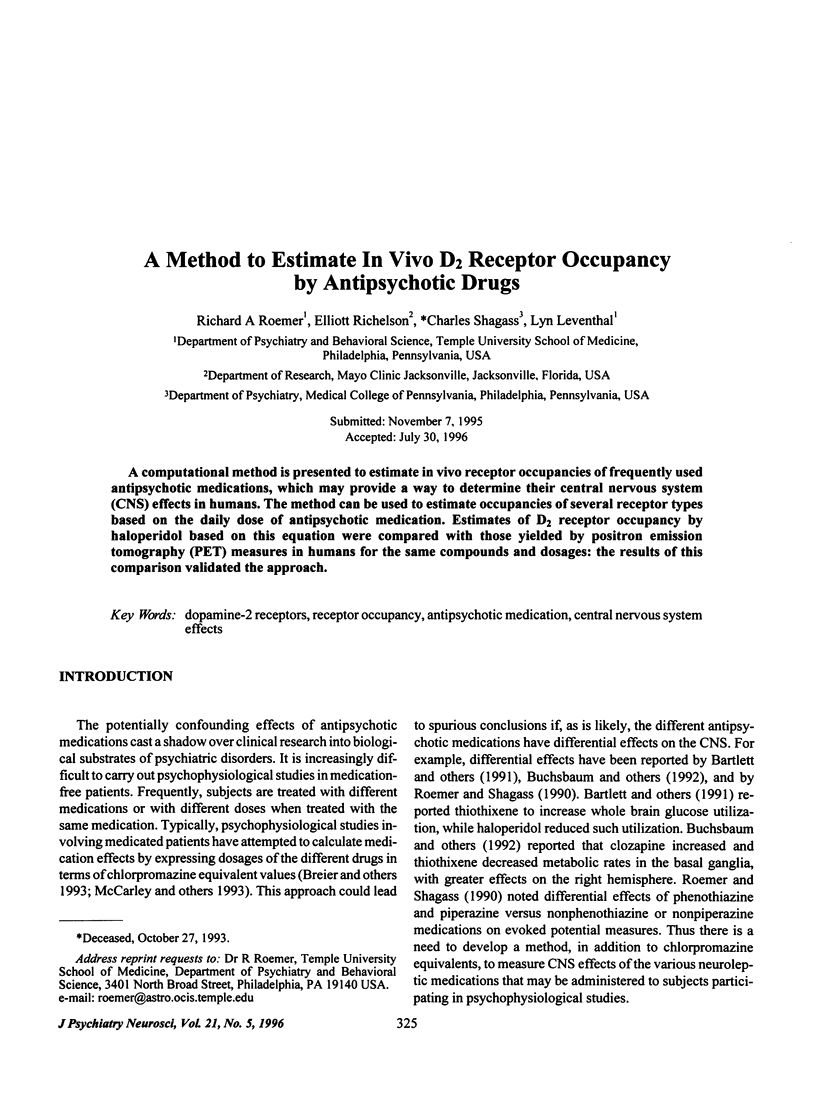
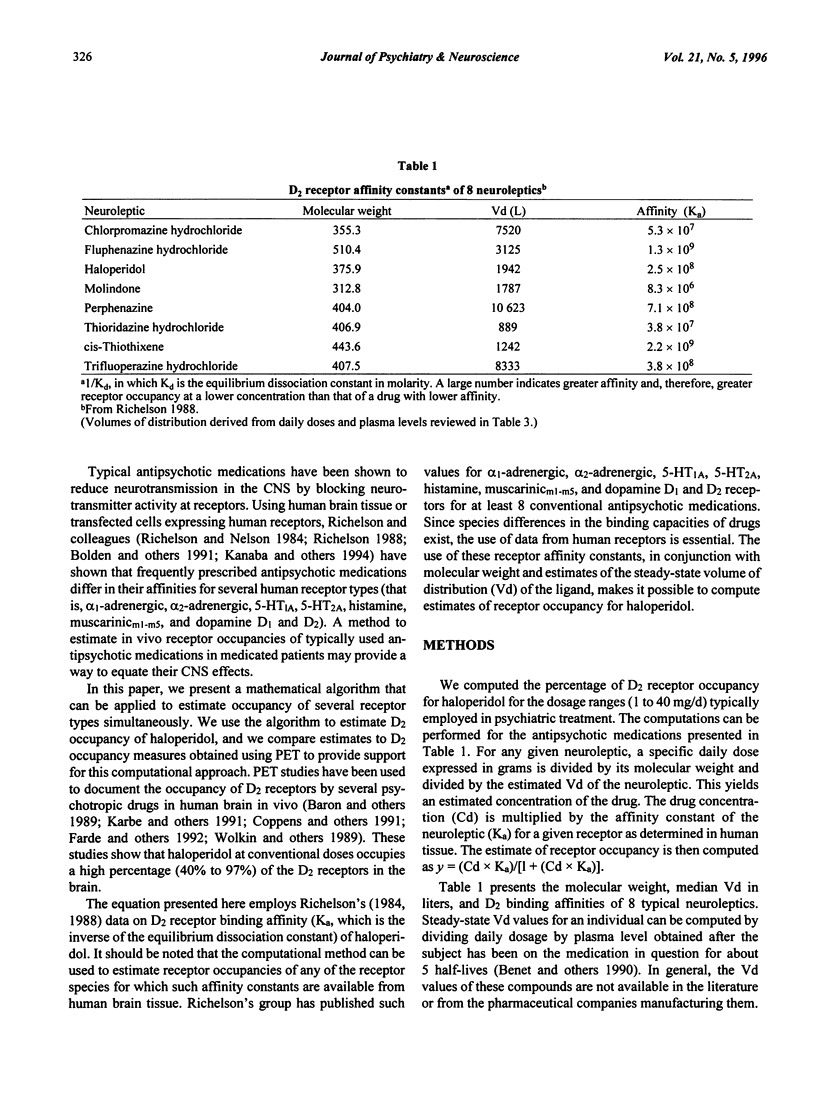
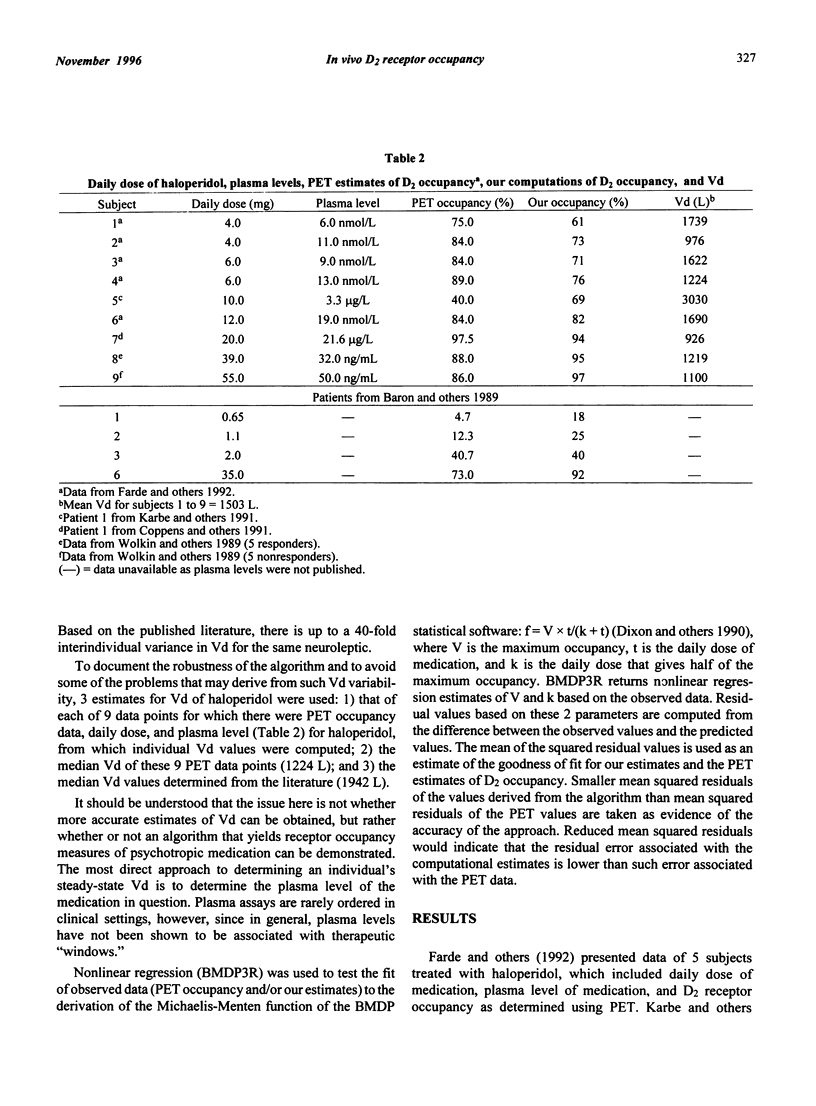
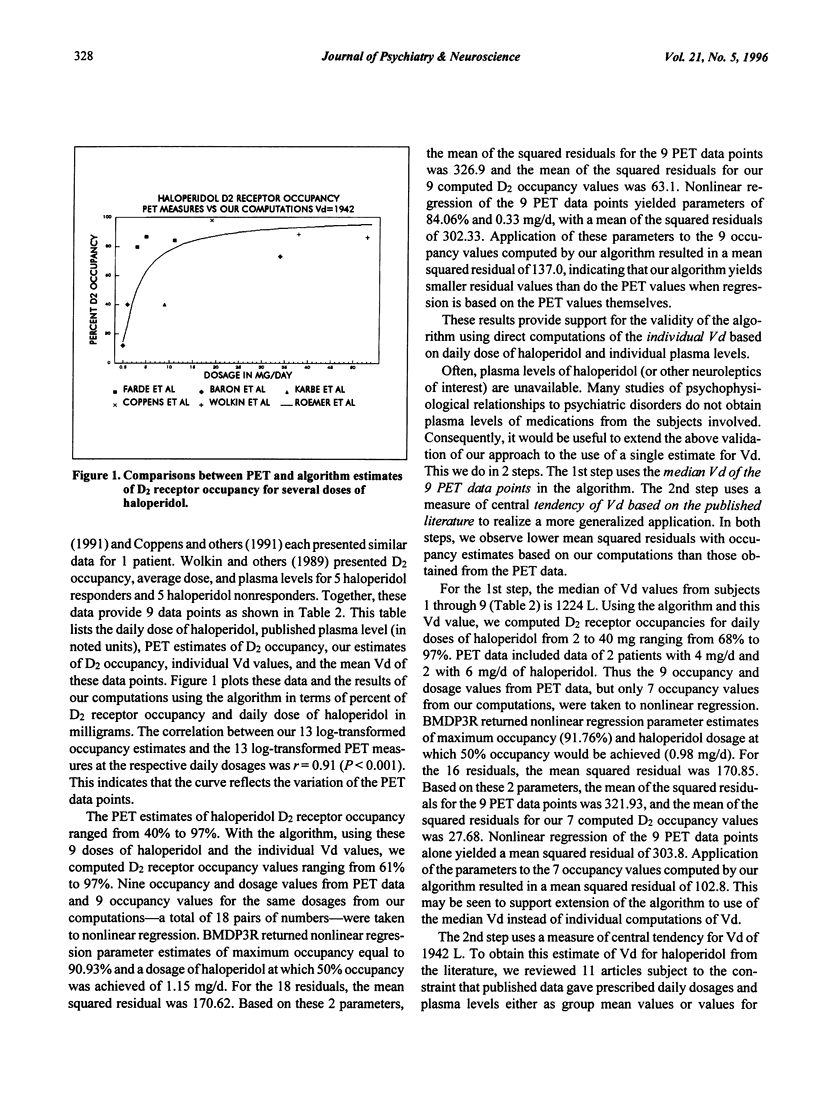
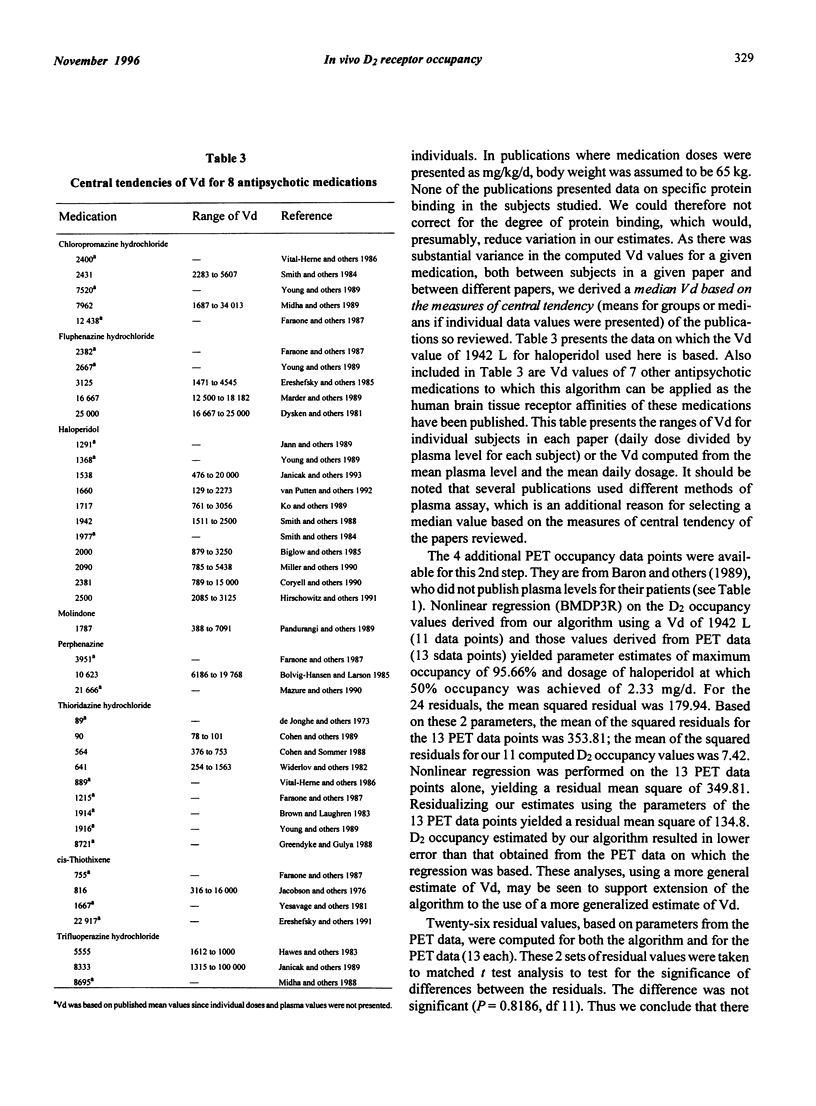
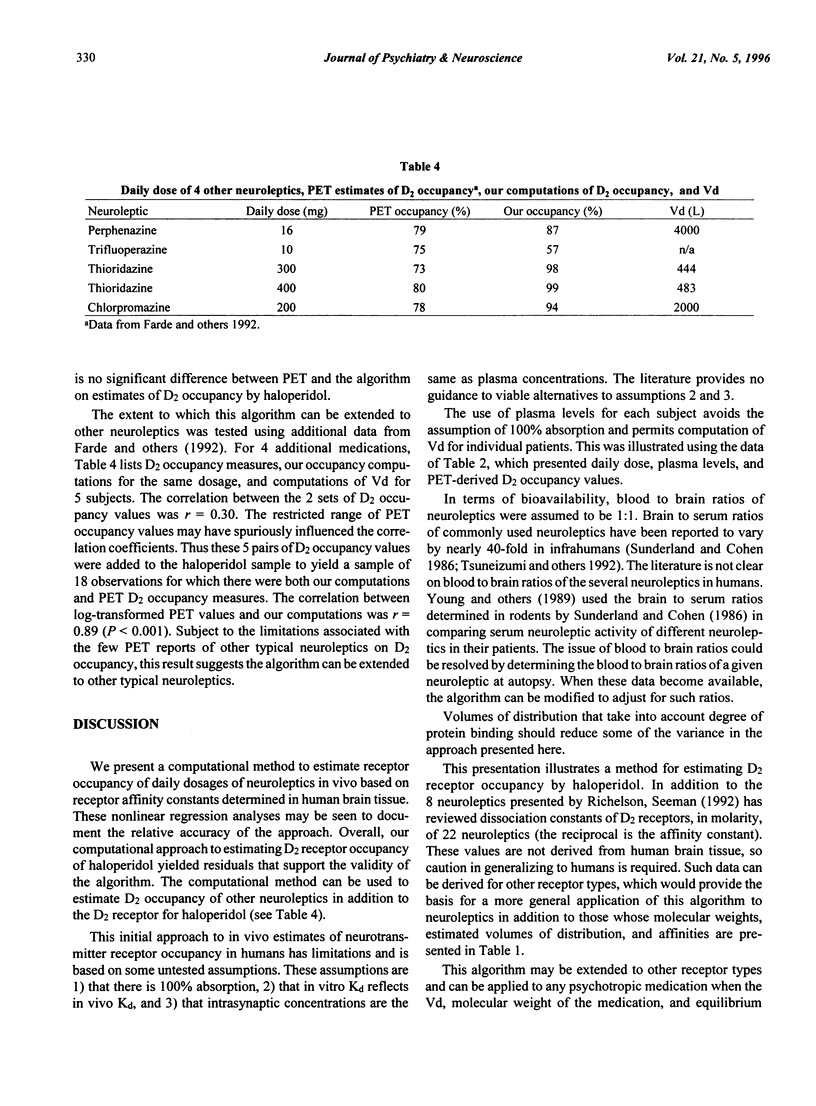
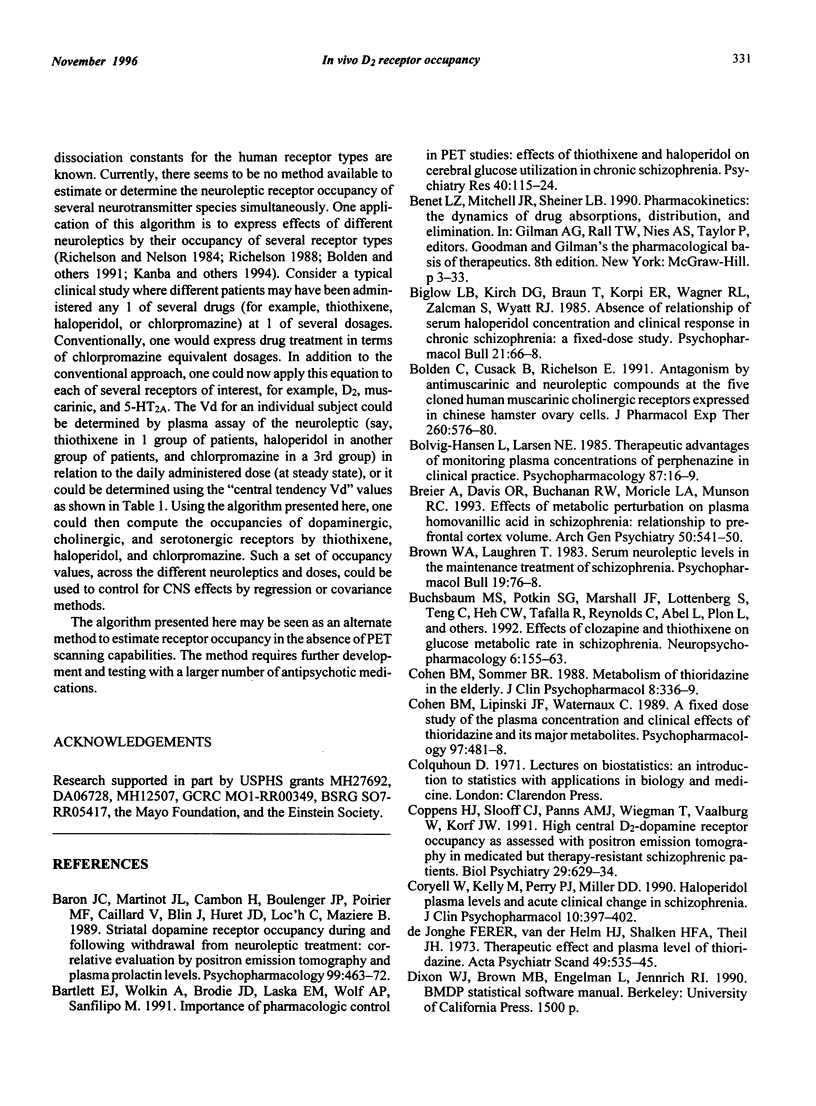
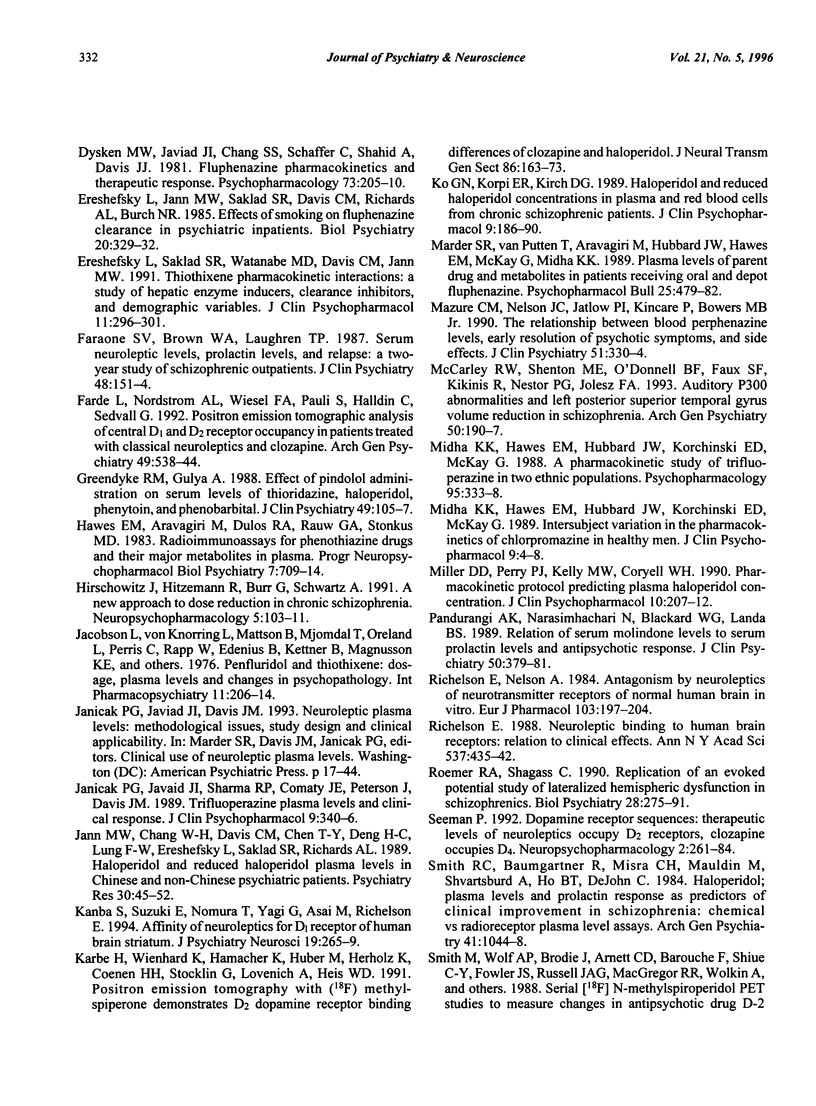
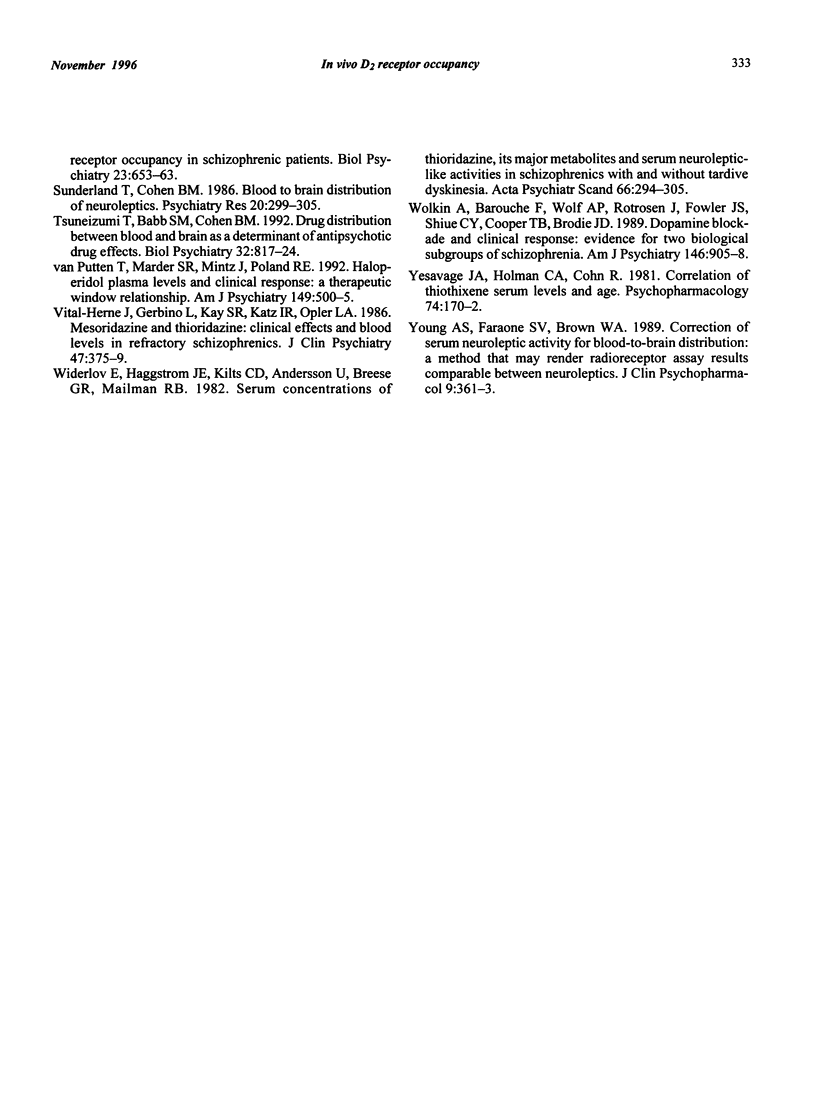
Selected References
These references are in PubMed. This may not be the complete list of references from this article.
- Baron J. C., Martinot J. L., Cambon H., Boulenger J. P., Poirier M. F., Caillard V., Blin J., Huret J. D., Loc'h C., Maziere B. Striatal dopamine receptor occupancy during and following withdrawal from neuroleptic treatment: correlative evaluation by positron emission tomography and plasma prolactin levels. Psychopharmacology (Berl) 1989;99(4):463–472. doi: 10.1007/BF00589893. [DOI] [PubMed] [Google Scholar]
- Bartlett E. J., Wolkin A., Brodie J. D., Laska E. M., Wolf A. P., Sanfilipo M. Importance of pharmacologic control in PET studies: effects of thiothixene and haloperidol on cerebral glucose utilization in chronic schizophrenia. Psychiatry Res. 1991 Oct;40(2):115–124. doi: 10.1016/0925-4927(91)90003-9. [DOI] [PubMed] [Google Scholar]
- Bigelow L. B., Kirch D. G., Braun T., Korpi E. R., Wagner R. L., Zalcman S., Wyatt R. J. Absence of relationship of serum haloperidol concentration and clinical response in chronic schizophrenia: a fixed-dose study. Psychopharmacol Bull. 1985;21(1):66–68. [PubMed] [Google Scholar]
- Bolden C., Cusack B., Richelson E. Antagonism by antimuscarinic and neuroleptic compounds at the five cloned human muscarinic cholinergic receptors expressed in Chinese hamster ovary cells. J Pharmacol Exp Ther. 1992 Feb;260(2):576–580. [PubMed] [Google Scholar]
- Breier A., Davis O. R., Buchanan R. W., Moricle L. A., Munson R. C. Effects of metabolic perturbation on plasma homovanillic acid in schizophrenia. Relationship to prefrontal cortex volume. Arch Gen Psychiatry. 1993 Jul;50(7):541–550. doi: 10.1001/archpsyc.1993.01820190043005. [DOI] [PubMed] [Google Scholar]
- Brown W. A., Laughren T. Serum neuroleptic levels in the maintenance treatment of schizophrenia. Psychopharmacol Bull. 1983;19(1):76–78. [PubMed] [Google Scholar]
- Buchsbaum M. S., Potkin S. G., Marshall J. F., Lottenberg S., Teng C., Heh C. W., Tafalla R., Reynolds C., Abel L., Plon L. Effects of clozapine and thiothixene on glucose metabolic rate in schizophrenia. Neuropsychopharmacology. 1992 May;6(3):155–163. [PubMed] [Google Scholar]
- Cohen B. M., Lipinski J. F., Waternaux C. A fixed dose study of the plasma concentration and clinical effects of thioridazine and its major metabolites. Psychopharmacology (Berl) 1989;97(4):481–488. doi: 10.1007/BF00439552. [DOI] [PubMed] [Google Scholar]
- Cohen B. M., Sommer B. R. Metabolism of thioridazine in the elderly. J Clin Psychopharmacol. 1988 Oct;8(5):336–339. [PubMed] [Google Scholar]
- Coppens H. J., Slooff C. J., Paans A. M., Wiegman T., Vaalburg W., Korf J. High central D2-dopamine receptor occupancy as assessed with positron emission tomography in medicated but therapy-resistant schizophrenic patients. Biol Psychiatry. 1991 Apr 1;29(7):629–634. doi: 10.1016/0006-3223(91)90132-6. [DOI] [PubMed] [Google Scholar]
- Coryell W., Kelly M., Perry P. J., Miller D. D. Haloperidol plasma levels and acute clinical change in schizophrenia. J Clin Psychopharmacol. 1990 Dec;10(6):397–402. doi: 10.1097/00004714-199010060-00003. [DOI] [PubMed] [Google Scholar]
- Dysken M. W., Javaid J. I., Chang S. S., Schaffer C., Shahid A., Davis J. M. Fluphenazine pharmacokinetics and therapeutic response. Psychopharmacology (Berl) 1981;73(3):205–210. doi: 10.1007/BF00422403. [DOI] [PubMed] [Google Scholar]
- Ereshefsky L., Jann M. W., Saklad S. R., Davis C. M., Richards A. L., Burch N. R. Effects of smoking on fluphenazine clearance in psychiatric inpatients. Biol Psychiatry. 1985 Mar;20(3):329–332. doi: 10.1016/0006-3223(85)90063-0. [DOI] [PubMed] [Google Scholar]
- Ereshefsky L., Saklad S. R., Watanabe M. D., Davis C. M., Jann M. W. Thiothixene pharmacokinetic interactions: a study of hepatic enzyme inducers, clearance inhibitors, and demographic variables. J Clin Psychopharmacol. 1991 Oct;11(5):296–301. [PubMed] [Google Scholar]
- Faraone S. V., Brown W. A., Laughren T. P. Serum neuroleptic levels, prolactin levels, and relapse: a two-year study of schizophrenic outpatients. J Clin Psychiatry. 1987 Apr;48(4):151–154. [PubMed] [Google Scholar]
- Farde L., Nordström A. L., Wiesel F. A., Pauli S., Halldin C., Sedvall G. Positron emission tomographic analysis of central D1 and D2 dopamine receptor occupancy in patients treated with classical neuroleptics and clozapine. Relation to extrapyramidal side effects. Arch Gen Psychiatry. 1992 Jul;49(7):538–544. doi: 10.1001/archpsyc.1992.01820070032005. [DOI] [PubMed] [Google Scholar]
- Greendyke R. M., Gulya A. Effect of pindolol administration on serum levels of thioridazine, haloperidol, phenytoin, and phenobarbital. J Clin Psychiatry. 1988 Mar;49(3):105–107. [PubMed] [Google Scholar]
- Hansen L. B., Larsen N. E. Therapeutic advantages of monitoring plasma concentrations of perphenazine in clinical practice. Psychopharmacology (Berl) 1985;87(1):16–19. doi: 10.1007/BF00431770. [DOI] [PubMed] [Google Scholar]
- Hawes E. M., Aravagiri M., Dulos R. A., Rauw G. A., Stonkus M. D. Radioimmunoassays for phenothiazine drugs and their major metabolites in plasma. Prog Neuropsychopharmacol Biol Psychiatry. 1983;7(4-6):709–714. doi: 10.1016/0278-5846(83)90050-7. [DOI] [PubMed] [Google Scholar]
- Hirschowitz J., Hitzemann R., Burr G., Schwartz A. A new approach to dose reduction in chronic schizophrenia. Neuropsychopharmacology. 1991 Sep;5(2):103–113. [PubMed] [Google Scholar]
- Jacobsson L., von Knorring L., Mattsson B., Mjörndal T., Oreland L., Perris C., Rapp W., Edenius B., Kettner B., Magnusson K. E. Penfluridol and thiothixene. Dosage, plasma levels and changes in psychopathology. Int Pharmacopsychiatry. 1976;11(4):206–214. [PubMed] [Google Scholar]
- Janicak P. G., Javaid J. I., Sharma R. P., Comaty J. E., Peterson J., Davis J. M. Trifluoperazine plasma levels and clinical response. J Clin Psychopharmacol. 1989 Oct;9(5):340–346. [PubMed] [Google Scholar]
- Jann M. W., Chang W. H., Davis C. M., Chen T. Y., Deng H. C., Lung F. W., Ereshefsky L., Saklad S. R., Richards A. L. Haloperidol and reduced haloperidol plasma levels in Chinese vs. non-Chinese psychiatric patients. Psychiatry Res. 1989 Oct;30(1):45–52. doi: 10.1016/0165-1781(89)90170-4. [DOI] [PubMed] [Google Scholar]
- Kanba S., Suzuki E., Nomura S., Nakaki T., Yagi G., Asai M., Richelson E. Affinity of neuroleptics for D1 receptor of human brain striatum. J Psychiatry Neurosci. 1994 Jul;19(4):265–269. [PMC free article] [PubMed] [Google Scholar]
- Karbe H., Wienhard K., Hamacher K., Huber M., Herholz K., Coenen H. H., Stöcklin G., Lövenich A., Heiss W. D. Positron emission tomography with (18F)methylspiperone demonstrates D2 dopamine receptor binding differences of clozapine and haloperidol. J Neural Transm Gen Sect. 1991;86(3):163–173. doi: 10.1007/BF01250702. [DOI] [PubMed] [Google Scholar]
- Ko G. N., Korpi E. R., Kirch D. G. Haloperidol and reduced haloperidol concentrations in plasma and red blood cells from chronic schizophrenic patients. J Clin Psychopharmacol. 1989 Jun;9(3):186–190. [PubMed] [Google Scholar]
- Marder S. R., Van Putten T., Aravagiri M., Hubbard J. W., Hawes E. M., McKay G., Midha K. K. Plasma levels of parent drug and metabolites in patients receiving oral and depot fluphenazine. Psychopharmacol Bull. 1989;25(3):479–482. [PubMed] [Google Scholar]
- Mazure C. M., Nelson J. C., Jatlow P. I., Kincare P., Bowers M. B., Jr The relationship between blood perphenazine levels, early resolution of psychotic symptoms, and side effects. J Clin Psychiatry. 1990 Aug;51(8):330–334. [PubMed] [Google Scholar]
- McCarley R. W., Shenton M. E., O'Donnell B. F., Faux S. F., Kikinis R., Nestor P. G., Jolesz F. A. Auditory P300 abnormalities and left posterior superior temporal gyrus volume reduction in schizophrenia. Arch Gen Psychiatry. 1993 Mar;50(3):190–197. doi: 10.1001/archpsyc.1993.01820150036003. [DOI] [PubMed] [Google Scholar]
- Midha K. K., Hawes E. M., Hubbard J. W., Korchinski E. D., McKay G. A pharmacokinetic study of trifluoperazine in two ethnic populations. Psychopharmacology (Berl) 1988;95(3):333–338. doi: 10.1007/BF00181943. [DOI] [PubMed] [Google Scholar]
- Midha K. K., Hawes E. M., Hubbard J. W., Korchinski E. D., McKay G. Intersubject variation in the pharmacokinetics of chlorpromazine in healthy men. J Clin Psychopharmacol. 1989 Feb;9(1):4–8. [PubMed] [Google Scholar]
- Miller D. D., Perry P. J., Kelly M. W., Coryell W. H., Arndt S. V. Pharmacokinetic protocol for predicting plasma haloperidol concentrations. J Clin Psychopharmacol. 1990 Jun;10(3):207–212. [PubMed] [Google Scholar]
- Pandurangi A. K., Narasimhachari N., Blackard W. G., Landa B. S. Relation of serum molindone levels to serum prolactin levels and antipsychotic response. J Clin Psychiatry. 1989 Oct;50(10):379–381. [PubMed] [Google Scholar]
- Richelson E., Nelson A. Antagonism by neuroleptics of neurotransmitter receptors of normal human brain in vitro. Eur J Pharmacol. 1984 Aug 17;103(3-4):197–204. doi: 10.1016/0014-2999(84)90478-3. [DOI] [PubMed] [Google Scholar]
- Richelson E. Neuroleptic binding to human brain receptors: relation to clinical effects. Ann N Y Acad Sci. 1988;537:435–442. doi: 10.1111/j.1749-6632.1988.tb42125.x. [DOI] [PubMed] [Google Scholar]
- Roemer R. A., Shagass C. Replication of an evoked potential study of lateralized hemispheric dysfunction in schizophrenics. Biol Psychiatry. 1990 Aug 15;28(4):275–291. doi: 10.1016/0006-3223(90)90655-l. [DOI] [PubMed] [Google Scholar]
- Seeman P. Dopamine receptor sequences. Therapeutic levels of neuroleptics occupy D2 receptors, clozapine occupies D4. Neuropsychopharmacology. 1992 Dec;7(4):261–284. [PubMed] [Google Scholar]
- Smith M., Wolf A. P., Brodie J. D., Arnett C. D., Barouche F., Shiue C. Y., Fowler J. S., Russell J. A., MacGregor R. R., Wolkin A. Serial [18F]N-methylspiroperidol PET studies to measure changes in antipsychotic drug D-2 receptor occupancy in schizophrenic patients. Biol Psychiatry. 1988 Apr 1;23(7):653–663. doi: 10.1016/0006-3223(88)90048-0. [DOI] [PubMed] [Google Scholar]
- Smith R. C., Baumgartner R., Misra C. H., Mauldin M., Shvartsburd A., Ho B. T., DeJohn C. Haloperidol. Plasma levels and prolactin response as predictors of clinical improvement in schizophrenia: chemical v radioreceptor plasma level assays. Arch Gen Psychiatry. 1984 Nov;41(11):1044–1049. doi: 10.1001/archpsyc.1983.01790220034006. [DOI] [PubMed] [Google Scholar]
- Sunderland T., Cohen B. M. Blood to brain distribution of neuroleptics. Psychiatry Res. 1987 Apr;20(4):299–305. doi: 10.1016/0165-1781(87)90090-4. [DOI] [PubMed] [Google Scholar]
- Tsuneizumi T., Babb S. M., Cohen B. M. Drug distribution between blood and brain as a determinant of antipsychotic drug effects. Biol Psychiatry. 1992 Nov 1;32(9):817–824. doi: 10.1016/0006-3223(92)90085-e. [DOI] [PubMed] [Google Scholar]
- Van Putten T., Marder S. R., Mintz J., Poland R. E. Haloperidol plasma levels and clinical response: a therapeutic window relationship. Am J Psychiatry. 1992 Apr;149(4):500–505. doi: 10.1176/ajp.149.4.500. [DOI] [PubMed] [Google Scholar]
- Vital-Herne J., Gerbino L., Kay S. R., Katz I. R., Opler L. A. Mesoridazine and thioridazine: clinical effects and blood levels in refractory schizophrenics. J Clin Psychiatry. 1986 Jul;47(7):375–379. [PubMed] [Google Scholar]
- Widerlöv E., Häggström J. E., Kilts C. D., Andersson U., Breese G. R., Mailman R. B. Serum concentrations of thioridazine, its major metabolites and serum neuroleptic-like activities in schizophrenics with and without tardive dyskinesia. Acta Psychiatr Scand. 1982 Oct;66(4):294–305. doi: 10.1111/j.1600-0447.1982.tb00308.x. [DOI] [PubMed] [Google Scholar]
- Wolkin A., Barouche F., Wolf A. P., Rotrosen J., Fowler J. S., Shiue C. Y., Cooper T. B., Brodie J. D. Dopamine blockade and clinical response: evidence for two biological subgroups of schizophrenia. Am J Psychiatry. 1989 Jul;146(7):905–908. doi: 10.1176/ajp.146.7.905. [DOI] [PubMed] [Google Scholar]
- Yesavage J. A., Holman C. A., Cohn R. Correlation of thiothixene serum levels and age. Psychopharmacology (Berl) 1981;74(2):170–172. doi: 10.1007/BF00432687. [DOI] [PubMed] [Google Scholar]
- Young A. S., Faraone S. V., Brown W. A. Correction of serum neuroleptic activity for blood-to-brain distribution: a method that may render radioreceptor assay results comparable between neuroleptics. J Clin Psychopharmacol. 1989 Oct;9(5):361–363. [PubMed] [Google Scholar]
- de Jonghe F. E., van der Helm H. J., Schalken H. F., Thiel J. H. Therapeutic effect and plasma level of thioridazine. Acta Psychiatr Scand. 1973;49(5):535–545. doi: 10.1111/j.1600-0447.1973.tb04445.x. [DOI] [PubMed] [Google Scholar]


